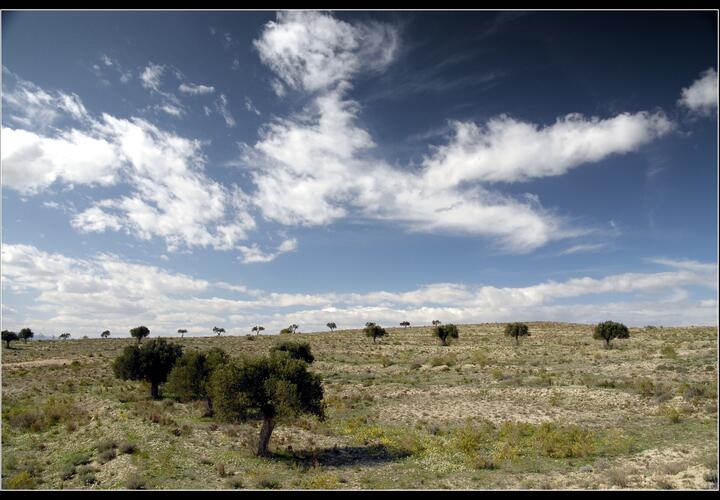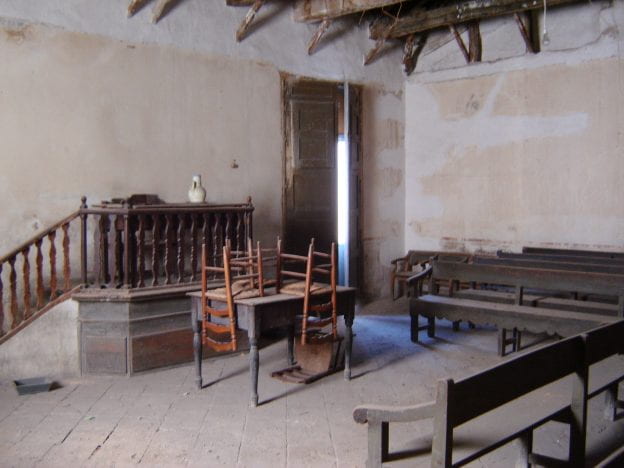What can economic history tell us about the future of water policy?

The Illiquidity of Water Markets, and Water Theft as Social Insurance
Auction-based water markets, which distribute the greatest amount of water to the highest bidders, have been lauded for their ability to meet demand efficiently. Amid increasing threats of water scarcity, they have become a favored approach in countries like the United States and Australia. However, analyses of water auctions’ efficiency have typically omitted key factors, such as rainfall volatility, sustainability of water supply, and farmers’ liquidity constraints (limitations on their cash to purchase water). In certain contexts, however, other water distribution systems may be more effective.

Espín-Sánchez is one of the organizers of the Program in Economic History, an activity of the Economic Growth Center.
Analyzing one of the oldest water markets in the world – the 700-year old auction system in Mula, Spain – Yale economic historian José Antonio Espín-Sánchez found that a recent shift to quotas increased revenues for poor farmers. To understand why, Espín-Sánchez and his co-author Javier Donna designed a model that could account for the factors typically omitted from similar studies – and then applied their model to Mula. Delving into the town’s history, including its punishment of water theft and irrigation misuse, and analyzing the effects of the recent shift from auctions to quotas, the findings shed light on water distribution’s local dynamics – and offers lessons for the future.
In the Spanish municipality of Mula, the switch from a 700-year old auction-based water market to a quota system provided 8% more revenue for farmers.
The results suggest that optimal water policy should be guided by a region’s local characteristics.
Auction-based water markets are most effective in regions with heterogeneous demand (varying levels of demand for water), low aggregate rain volatility (where rainfall is consistent from year to year), and high idiosyncratic rain volatility (varies between different farms or sub-regions).
Quota systems are most effective in small regions where crop diversity and water demand are both relatively homogenous, where farmers’ liquidity constraints are high, and where there is high aggregate rain volatility.
Mula’s centuries-old criminal justice system, with flexible punishments for water theft, functions as social insurance for vulnerable farmers; judges concentrated harsh punishments on wealthy recidivists.
Read the publication
The Illiquidity of Water Markets: Efficient Institutions for Water Allocation in Southeastern Spain
Javier D. Donna and José Antonio Espín-Sánchez, 2021. Working Paper.
Quotas versus Auctions
In theory, auction-based water markets are very efficient: commercial bidders who want the most water and have a high willingness to pay are able to obtain greater quantities. When a region is “heterogenous” in its need for water – for example, if many different crops are being grown, needing water at different times of the year – then water markets are effective, remaining competitive while responding to the needs of buyers. In such a context, farmers may trade freely among themselves to improve their water allocations, increasing efficiency.
Water markets are also effective in situations where a region is large and receives varying amounts of precipitation, meaning that some farmers will require less irrigation than others. A difference in precipitation across a region during a single time period is referred to as idiosyncratic rain volatility; a difference in rainfall across the whole region between years is referred to as aggregate rain volatility. A possible downside to water markets is that farmers may lack the cash to access it at the right time. If they access revenue only after the harvest season (and this revenue may vary due to weather and other factors), they may not have money available to purchase water when they need it before the harvest.
In a quota system, by contrast, farmers are periodically assigned an amount of water proportional to the size of their land. A key benefit of quotas is that they offer poor farmers with consistent access to water, even if they are liquidity-constrained. Quotas can raise efficiency relative to auctions when the region in question is small, when the farming is homogenous, and when there is high aggregate rain volatility and low idiosyncratic rain volatility. Because the demand for water will be relatively uniform in these contexts, the water market is limited in efficiency.
New findings on an ancient system
The water markets in the region of Murcia, Spain, where Espín-Sánchez and his coauthor based their study, has had enduring interest for economists: in 1911, the leading article of the first volume of the American Economic Review written by Katharine Coman cites this auction system as a bad example. Murcia’s system dates to the year 1243, when the Christian infante Alfonso of Castile conquered the region from its Islamic rulers.
Learn about the Program in Economic History
The Program exists within the Economic Growth Center to foster research of the long-term development of economies. Visit the Program's website for information on weekly events, mini-conferences, and other program activities.

“The invading Templars were warriors, not farmers,” Espín-Sánchez said. “They created a corporation that [had] the property rights over the water…[which sold] water to the farmers every year.” Water, necessary for supporting the irrigation of the farms and ranches in the region as well as for domestic life, was secured in a collection of aljibes, or cisterns. The ancient corporation, and its market system of water distribution, have remained intact through to the modern day. In the early twentieth century, a reservoir was constructed for the town, and farming transitioned from wine-making and olive-farming to the cultivation of citrus and apricots, which required significantly more water.
In 1966, the water market in Mula – a small municipality in Murcia – was replaced by a quota system. Espín-Sánchez and his co-author, Javier Donna of the University of Florida, empirically investigate how this institutional change affected efficiency and farmer welfare. Most farmers in Mula grow similar crops – apricots and citrus, both of which require significant amounts of water. It is also a particularly dry region that experiences high annual aggregate rain volatility: in years where there was little rainfall, demand for water can often exceed supply. Due to the lack of adequate historical data, Espín-Sánchez and Donna built a structural econometric model using detailed input data (units of water purchased, rainfall amount, number of apricot trees, etc.) to compute farming output under the two systems. To ensure consistency, they also focused only on apricot growers. Using estimated water demand and liquidity constraints, they found that farmers would obtain 8% more revenue under the quota system.

An old auction room in Mula, Spain. Photo courtesy José Antonio Espín-Sánchez.
Water theft as social insurance
In a separate paper, Espín-Sánchez and Donna study Murcia’s unique legal system – particularly its treatment of irrigation misuse and water theft – in order to understand the social and legal dimensions around water scarcity in this drought-prone region. Much as water quotas protect poor farmers by allowing them to access water in years when they are experiencing financial hardship, the researchers found that Murcia’s legal system also affords “social insurance” to poor farmers through flexible punishments for water theft in years of drought.
As an ancient, socially stable, and economically efficient self-governing territory, Murcia has used the same system for resolving water conflicts for centuries. Specifically, judges in Murcia (called the “Council of Good Men”) use a flexible scale of punishment that takes into consideration a range of factors, including whether the irrigation misuse or water theft was committed during a drought, and whether the perpetrator is wealthy and a repeat offender.
“This treatment is very fair”, Espín-Sánchez said. “It will punish greedy farmers or rich farmers, and it will be lenient with poor farmers. This is good because it creates a kind of [social] insurance for the farmers…the proof that this is successful is that they’ve been doing it for almost 1000 years, and they still do it.” This social insurance allows for leniency on poor farmers during drought years, when they are more likely to struggle, while deterring criminal activity from wealthy farmers.
To further examine this flexible form of justice, Espín-Sánchez and Donna developed a dynamic model that described how judges weighed the benefits of both criminal deterrence and social insurance for farmers in distributing penalties for water-related violations. Utilizing judicial records from 1851 to 1948, they found that wealthy offenders (identified by the honorific “don” next to their name in historical records) were punished more harshly than those who were poor, and repeat offenders were punished more harshly than first-time offenders. Moreover, wealthy farmers were punished particularly harshly when the victim was a poor farmer.
This progressive system (implemented by judges who were themselves farmers) thus provides social insurance for poor farmers while also preventing opportunistic wealthy farmers from preying upon poorer ones. Given the system’s effectiveness at utilizing the close-knit region’s social aspects to maintain a low crime rate and protect poor farmers, the long-lived Council of Good Men has been recognized as part of UNESCO’s Intangible Cultural Heritage.
Water distribution in the present day
Water scarcity is accelerating in many regions around the globe, including India, Latin America, and the United States – and as these issues become an increasingly global concern, so too will water theft and inequitable water access. As such, Espín-Sánchez and Donna’s research is timely and raises important questions for the future of water distribution. What combination of regulations will efficiently allocate the increasingly scarce global water supply, and what methods of conflict resolution are most effective for sustainable water resource management?
Espín-Sánchez and Donna’s research suggests that there is no one-size-fits-all solution and that local factors matter greatly. Their paper comparing water markets and quota systems, in particular, suggests that in regions like India, a quota system may be beneficial for poor farmers who often face liquidity constraints. Quota systems would be particularly efficient when operating in small sub-regions with relatively homogenous crops and high aggregate rain volatility, it will likely be efficient. However, it can be difficult to assess whether quotas or water markets would be more effective in regions with overlapping public and private water ownership, where distorted prices can make it challenging to estimate water demand.
Likewise, much as quota systems can support farmers through times of financial hardship, Mula’s time-tested legal system emphasizes the importance of protecting poor farmers from irrigation misuse and water theft. As resources become increasingly scarce, progressive legal systems and water distribution methods can endure enhanced pressure and scrutiny. Mula’s ancient traditions, which prioritize the protection of the poorest and most vulnerable members of society, offer a lesson in how flexible, socially conscious economic and justice systems can bolster communities through times of drought and hardship.
Research Summary by Clare Kemmerer